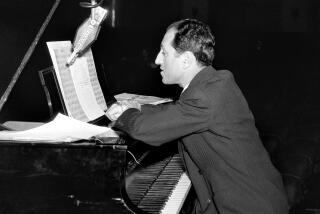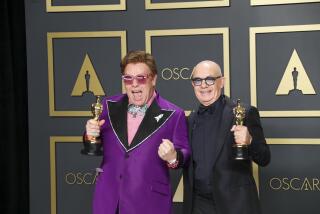A Time to Wax Rhapsodic
- Share via
George Gershwin was born 100 years ago Saturday, and for the past 75 years, ever since the epoch-making premiere of “Rhapsody in Blue,” on Feb. 12, 1924, in New York City, music critics have been trying to figure out what to make of him. His music has been caught in the cross-fire between those who see mass culture as the most valid expression of our time, and those who see it as the end of Western civilization. Meanwhile, the public has held Gershwin’s music in its warm embrace through booms, depressions and wars and countless changes of musical fashion.
Unlike many artists who only achieve posthumous recognition, Gershwin rose to fame overnight with “Rhapsody in Blue.” It was the right music at the right time. Along with vamps, bathtub gin and raccoon coats, the Jazz Age produced a group of writers who celebrated the new forms of mass culture in books, the original Vanity Fair and a host of other trendy periodicals. For Carl Van Vechten, Isaac Goldberg and Gilbert Seldes, Gershwin symbolized a new cultural era and a new America liberated from the puritanism, racism and snobbery of the past. They were looking for an expression of the age and they were surprisingly receptive to the idea that it would come from Tin Pan Alley.
These Jazz Age prophets opened public opinion to new cultural forms and media. The classical music world of the early ‘20s was not the uptight bunch of stuffed shirts and dowagers you see in “A Night at the Opera.” Although bigots denounced jazz as a toxic substance, the audience for bandleader Paul Whiteman’s “Experiment in Modern Music,” as he termed the Lincoln’s birthday concert that premiered “Rhapsody in Blue,” was a “Who’s Who” of the musical and cultural elite.
Whiteman had cleverly appointed a panel of distinguished musicians, including Sergei Rachmaninoff, Jascha Heifetz, Efrem Zimbalist and Alma Gluck, to “judge” the results of his experiment--though their verdict was never recorded. Their presence attracted a full house of prominent artists and socialites to a performance by what was, after all, a high-class dance band.
Whiteman’s press releases also promised a “syncopated tone poem” by Irving Berlin, who was far more famous than Gershwin at the time. In 1917, Van Vechten had celebrated Berlin in an article called “The Great American Composer,” despite the fact that Berlin was musically illiterate. He expected the composer of “Alexander’s Ragtime Band” to create symphonies and operas, albeit syncopated ones. Gershwin was to play the role that Van Vechten had already scripted for Berlin.
“Rhapsody in Blue,” however, went beyond the audience’s expectations and broke down aesthetic categories in a way that left most of the critics spinning. Only Van Vechten, who called “Rhapsody” “the foremost serious effort by any American composer,” saw that it was just a forecast of things to come.
“I think something might be done in the way of combining jazz and the moving-picture technique,” he advised Gershwin, who went on to write for many a movie and whose “An American in Paris” eventually landed on the big screen. Van Vechten saw that the new media made the concert hall obsolete. Gershwin was the first American composer who felt entirely at home with recordings, radios and the movies.
For the more traditional critics, “Rhapsody” was a mixed bag, novel but crude, melodious but shapeless. Few of them, however, faced up to the fact that the work was, in its disarmingly innocent way, an act of cultural sacrilege that broke down the wall of the temple of art. Gershwin made classical music out of the same cloth as commercial music. He was not the first composer to mix high and low elements. But in the European tradition, the “low” element was folk music, a pure, simple and rural expression of national identity.
Gershwin created a new kind of synthesis. His popular songs were not folk music and were not rooted in the land or in an unambiguous ethnicity. They were spawned on the sidewalks of New York by a “swarthy” young man whose parents could barely speak English. They were urban, and alien and patently commercial, mass-manufactured objects. And their apparent Americanism was a mishmash, as composer-critic Virgil Thomson noted with condescension, of hot Harlem rhythms, plaintive synagogue wails and the suspect theatricality of the Emerald Isle.
Gershwin’s classical music brought these suspect elements into the concert hall without apologies and with irresistible pizazz.
For critics on the anti-Semitic right, as well as those on the anti-capitalist left, the new popular music was inherently corrupt, a threat to decent American values or an opiate of the masses. Between the anti-pop extremes, Gershwin found support from lifestyle modernists such as Van Vechten, but was cast aside by musical modernists such as Copland and Thomson. They dismissed his music as mere tinsel, unworthy of comparison with their heroes Stravinsky, Milhaud or Satie. These European composers had also incorporated jazz into their music, but the results, Stravinsky’s “Soldier’s Tale” or Milhaud’s “Creation of the World,” were clearly differentiable from the commercial product, as Gershwin’s “Rhapsody” was not.
The criticism of Gershwin’s music by other American composers, and, often, their personal animus against Gershwin, suggests that they felt that Gershwin had not just leveled the walls of the temple but had also installed the money-changers as priests. To this day, serious American composers draw a line in the sand between themselves and anyone who makes it in the commercial world; don’t expect Danny Elfman to win a Pulitzer Prize any time soon.
The debate about the value of mass culture lives on in the clash of pop apologists and neoconservative defenders of high art. A small dose of Gershwin, however, silences all these academic anxieties. For while his synthesis of black and white and high and low may have been revolutionary, the music itself is as trustworthy as an old friend and as nostalgically erotic as an old flame. “Rhapsody in Blue,” Concerto in F and “An American in Paris” are some of the few works of 20th century music guaranteed to put a smile on your face and a lilt in your walk. And the music Gershwin wrote after the Jazz Age died, “Porgy and Bess” and late songs such as “They Can’t Take That Away From Me” and “Our Love Is Here to Stay,” tug at your heart as well. What really sets Gershwin apart so miraculously from the entire field of American composers is the way he traveled from the innocence of “Rhapsody in Blue” to the compassion of “Porgy and Bess” in just 10 years, the way his music grew spiritually as well as technically.
That’s the reason his untimely death at age 38 was mourned by an entire nation and the reason we celebrate his music today.
*
Composer and critic David Schiff’s “Gershwin: Rhapsody in Blue” (Cambridge Music Handbooks) was published last year.
More to Read
The biggest entertainment stories
Get our big stories about Hollywood, film, television, music, arts, culture and more right in your inbox as soon as they publish.
You may occasionally receive promotional content from the Los Angeles Times.










